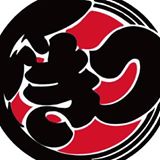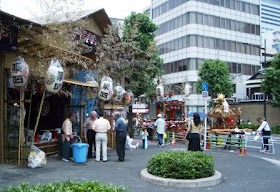Tsukiji was dead. Contrary to all
expectations, when we arrived there wasn’t a single soul to be seen. The place
was deserted. Disconcertingly so. We wandered with a growing sense of
trepidation, wondering what might have happened? … I’d previously read an
article on Tsukiji in the National Geographic (November, 1995) which had said that Tsukiji – the largest and busiest fish
market in Japan – never slept. In fact, the place had famously inverted day and
night, with its employees sitting down to dinner and cold glasses of beer at
the end of a ‘hard day’s night’, just as the rest of Tokyo was waking up and
starting to think about breakfast.
Located south of Ginza, Tokyo’s
Knightsbridge, on the edge of Tokyo Bay, Tokyo Central Wholesale Food Market, more popularly known as Tsukiji – meaning
“reclaimed land” – dates back to the Edo Period when, following the disastrous
Great Fire of Meireki (also known as the Furisode Fire) of 1657 which destroyed nearly
70% of the capital, much of the debris from the city was used to consolidate this
area which was previously marshland. It then became a place occupied by the grand
mansions and large gardens of the feudal elite, the daimyō lords of the outlying provinces, where they lived when they
were visiting the Shogun’s capital, as they were periodically obliged to do.
Following the Meiji Restoration in 1868 the area became a special residential district set aside for foreigners. The area changed its character once again after
another natural disaster, the Great Kanto Earthquake of 1923, when the market
relocated here from nearby Nihonbashi. The current market complex began
operation in 1935, but, as it occupies an area of prime real estate close to
the upmarket retail and business districts of Ginza and the Tokyo waterfront,
over the years it’s often been proposed to relocate the market elsewhere, and,
currently it looks very likely to do so in order to allow redevelopment ahead
of the 2020 Olympic Games.
 From the lavish photos accompanying
the National Geographic article which
I’d read, I was expecting to see the water sloshed halls of the market teeming
with battered white polystyrene boxes filled with glinting heaps of ice and a
myriad array of fish with iridescent scales glittering under rows of electric
lights, and the market’s distinctive electric carts flying about the place,
weaving in and out of the aisles and deftly dodging collisions with oncoming
forklift trucks and other delivery vehicles. The produce sold here is brought
in from all regions of the Pacific and beyond – eels from the waters around
Taiwan; salmon from the coastal waters off Chile; enormous tuna from the
Southern or Antarctic Ocean south of Australia; as well as, sanma (秋刀魚)
and hokke (ホッケ)
two kinds of mackerel from the local waters around Japan (these are two of my
favourites when in Japan, they’re delicious when grilled over hot coals), not
to mention all the many kinds of sea slugs, sea urchins, plus plenty of
different types of shellfish and seaweed too. Around some two thousand tonnes
of seafood pass under the auction hammers here daily. The maguro マグロ (tuna) are a sight to
behold – depending on the quality, their huge shiny silver frozen carcasses can
sell for between 600,000 and one million Japanese Yen apiece (100 Yen currently
being just over 50 pence, so up to almost £5,500!).
From the lavish photos accompanying
the National Geographic article which
I’d read, I was expecting to see the water sloshed halls of the market teeming
with battered white polystyrene boxes filled with glinting heaps of ice and a
myriad array of fish with iridescent scales glittering under rows of electric
lights, and the market’s distinctive electric carts flying about the place,
weaving in and out of the aisles and deftly dodging collisions with oncoming
forklift trucks and other delivery vehicles. The produce sold here is brought
in from all regions of the Pacific and beyond – eels from the waters around
Taiwan; salmon from the coastal waters off Chile; enormous tuna from the
Southern or Antarctic Ocean south of Australia; as well as, sanma (秋刀魚)
and hokke (ホッケ)
two kinds of mackerel from the local waters around Japan (these are two of my
favourites when in Japan, they’re delicious when grilled over hot coals), not
to mention all the many kinds of sea slugs, sea urchins, plus plenty of
different types of shellfish and seaweed too. Around some two thousand tonnes
of seafood pass under the auction hammers here daily. The maguro マグロ (tuna) are a sight to
behold – depending on the quality, their huge shiny silver frozen carcasses can
sell for between 600,000 and one million Japanese Yen apiece (100 Yen currently
being just over 50 pence, so up to almost £5,500!).
Tsukiji Hongan-ji, built in 1934 is one of the largest and most Indian-looking of Tokyo's Buddhist Temples
Tsukiji is quite a sight to behold,
hence why a lot of overseas visitors to Tokyo rouse themselves early from their
hotel beds on at least one day during their visit to see it, but naturally, for
locals alike, it’s also a Mecca for food lovers in quest of the freshest sushi
and sashimi. There are lots of places here to sample perhaps the most
distinctive of Japan’s signature culinary delights. Having wandered around the
bizarrely empty place for a while we eventually found one small restaurant open
down a side street, next door to a little knife vendor’s shop, selling the
sharpest knives of varying sizes for filleting fish and slicing the finest
(in both senses of the term) cuts of sashimi. Here, at this little family run eating
house, we found out why the whole place was so quiet. What we initially thought
was our misfortune to have turned up on a closed day turned out to be our very good
fortune, as today was the day of the Tsukiji
Shishi Matsuri – a local Shinto religious festival.
Mikoshi (御輿) are very ornate, gilded sacred palanquins which
are used throughout Japan to parade an effigy of the local kami 神 (the spirit, god, or genius loci) of a Shinto shrine through
the streets of its district or town. Often these mikoshi do not carry the actual
sacred effigy from the shrine itself, but rather a ritually invested totem or substitute
imbued with the spirit of the local kami. These processions are far from the
dour, solemn perambulations which the expectations of Westerners and their own
experience of Christian pageantry might naturally expect, but are often in fact
rather boisterous and exuberant spectacles, as the locals shake and jostle the
mikoshi through the streets whilst singing and chanting as they go. According
to some of the books I’ve read this liveliness is a relatively modern custom
and in some parts of Japan a more sedate style of procession is apparently still
practiced.
 Sitting in the restaurant we
gradually became aware of the rising hubbub as the procession from Tsukiji’s
Namiyoke Inari-jinja, the local shrine, approached. As the sound grew louder I
stepped outside with my camera and was swiftly engulfed, cut off from the
restaurant, as a great surge of people, all dressed in the colours of their
local wards, swelled to completely fill the narrow street. The teams carrying
the mikoshi were wearing short jackets, called happi
(法被), and split-toed canvas shoes with rubber soles,
known as jikatabi (地下足袋),
both of these are common kinds of everyday work wear. Some of the men looked like they’d
forgotten to put on their trousers, but this was because they were wearing fundoshi (ふんどし), a traditional kind of loincloth. They were
carrying a number of different mikoshi. I’ve read that these can often be
extremely heavy, and can even weigh in at around a ton. I managed to shoot a
couple of short films which really caught the vibrant atmosphere and noise of
the procession.
Sitting in the restaurant we
gradually became aware of the rising hubbub as the procession from Tsukiji’s
Namiyoke Inari-jinja, the local shrine, approached. As the sound grew louder I
stepped outside with my camera and was swiftly engulfed, cut off from the
restaurant, as a great surge of people, all dressed in the colours of their
local wards, swelled to completely fill the narrow street. The teams carrying
the mikoshi were wearing short jackets, called happi
(法被), and split-toed canvas shoes with rubber soles,
known as jikatabi (地下足袋),
both of these are common kinds of everyday work wear. Some of the men looked like they’d
forgotten to put on their trousers, but this was because they were wearing fundoshi (ふんどし), a traditional kind of loincloth. They were
carrying a number of different mikoshi. I’ve read that these can often be
extremely heavy, and can even weigh in at around a ton. I managed to shoot a
couple of short films which really caught the vibrant atmosphere and noise of
the procession.
A little book on Japan’s native Shinto
religion which I own, titled Shinto: The Kami Way by Sokyo Ono (Tuttle, 1962), gives the following explanation: “As a rule, the procession may be said to
have one or more of the following meanings: (1) It may signify the going out to
welcome to the shrine a kami coming from a far-away world or coming down from
the kami-world (shinkai). This may be the reason why in some cases a procession
in starting from a shrine is calm, as if travelling incognito, while on the
return journey it is sometimes merrily animated or proceeds in the darkness
with all the lights in the shrine extinguished. (2) It may signify a visit to
some place in the parish which has a special spiritual or historical
significance for the kami. (3) It may be an occasion for the kami to pass
through the parish and bless the homes of the faithful. (4) And finally it may
commemorate the historic processions of some Imperial messengers or feudal
lords on their way to a shrine. Probably in most cases the procession has some
historical significance related either to the appearance of the kami, the
founding of the shrine, or some outstanding historical event in the life of the
community.”
There was a real, joyous and lively
atmosphere of community as the procession swelled and filled the neighbourhood,
with lots of friendly, smiling faces all around. As the procession moved on and
so began to thin I managed to dash back across the street through the throng of
people to the restaurant, to finish our meal. The restaurant owner joked that
I’d been gone so long he thought I’d been swept away by the merry tide of
revellers. If Tsukiji was dead at the start of this, the day I first visited it
in 2005, it certainly ended by coming to life in a most unexpected and
interesting way.


















Friends of mine have visited the fish market and found to be a fascinating place. So I hope you managed to get there in the end even though it sounds like you had a wonderful and unexpected experience. Looks like some insane knives in that shop as well.
ReplyDeleteI did indeed. I've spent a lot of time in Japan over the years and even lived there for a time. I've visited quite a few different fish markets across Japan. The knife shops are fantastic. I bought some excellent ceramic knives there which are great for preparing food! ... The big ones in the shop window are used for chopping up whole frozen tuna, I think.
ReplyDelete